The 2013 MacBook Air Review (13-inch)
by Anand Lal Shimpi on June 24, 2013 12:01 AM ESTAbsolutely Insane Battery Life
With Haswell ULT, Intel aggressively focused on driving down total platform power consumption. It turns out that although Intel did a wonderful job of driving down CPU power consumption over the years, it did nothing to make the rest of the platform keep up. With Haswell ULT, all of that changed. Intel is being frustratingly cagey with giving up real details on exactly what’s going on with Haswell ULT, but here’s what I’ve been able to piece together.
For starters, Haswell ULT brings the PCH (Platform Controller Hub) on-package. The PCH is responsible for all SATA, USB, PCIe 2.0 and other rest-of-system interfaces. Bringing it on package reduces the amount of power needed to drive traffic between the CPU and PCH, which in turn helps reduce platform power.
The PCH also moves down to 32nm, helping further reduce power consumption. Haswell ULT silicon itself is binned for lower voltage/power operation. The combination of Haswell ULT CPU and PCH are both included in the new 15W TDP (there’s a 28W version as well but not used in the MacBook Air).
Haswell ULT supports lower power sleep states (up to C10) than the standard mobile or desktop parts (C6/C7).
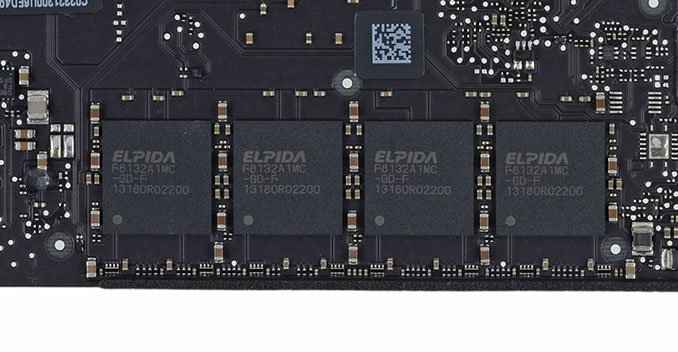
Image Courtesy iFixit
The other big change, and one that Apple is among the first (only?) to take advantage of is Haswell ULT’s support for LPDDR3. Standard DDR3 operates at 1.5V, while low-voltage DDR3L drops that down to 1.35V - the two standards are otherwise identical. LPDDR3 on the other hand drops voltage even further (1.2V) while introducing architectural features to drive power down even lower. LPDDR3‘s power advantage is why it’s frequently used in smartphones vs. DDR3L. The biggest downside is cost. Apple has historically not had an issue with spending a bit extra to get a better overall experience, so it’s not surprising to see the MacBook Air ship with LPDDR3.
Overall bandwidth remains unchanged despite the move to very low power memory. We’re still dealing with a 128-bit wide memory interface with a 1600MHz datarate. Note the impact this has on DRAM device layout on the PCB itself. Last year's model required 16 DDR3L devices, compared to 4 x 32-bit LPDDR3 devices here. Anyone else smell laptop/tablet convergence coming this way?
Haswell ULT also enables support for Intel’s Power Optimizer framework. I’ve talked about this extensively over the past several months, but it’s effectively a messaging system that allows all devices/controllers within a system to coordinate going into sleep states during periods of idle time. Of all of the platform power optimizations, this is the only one that isn’t currently taken advantage of in OS X. You’ll have to wait for OS X Mavericks to realize these gains.
Apple also boosted overall battery capacity on the MacBook Airs by roughly 8%. The increase in battery capacity had no impact on weight. Although it’s not immediately apparent, I would assume that Apple’s new SSDs also support DevSleep (DEVSLP) and Runtime D3.
The result of all of this is a downright tremendous improvement in battery life. OS X already did very well in the idle power department. Haswell’s FIVR (Fully Integrated Voltage Regulator) can more quickly/aggressively enter and exit low power states. The combination of which is really the perfect storm for increasing battery life.
On the 13-inch MBA, Apple claims up to 12 hours of usage on a single charge.
Apple even revised its own testing in order to make its quoted battery life numbers more realistic. Previously it ran all of its own battery life tests at 50% brightness, but starting with the MacBook Air Apple’s quoted battery life numbers are at 75% brightness. Our tests by comparison are at 81.5% (200 nits on the MBA). Apple’s changes to its battery testing methodology actually tend to unintentionally mirror ours. Our first Mac battery life tests ran at roughly 50% brightness (100 nits).
So how did the MacBook Air fare in our testing? To find out I turned to our updated 2012 battery life test suite, first introduced with the 15-inch rMBP review.
The light and medium suites are inherently related - they use the same workload and simply vary the aggressiveness of that workload. The light test hits four different websites every minute, pausing for nearly the entire time to simulate reading time. Flash is enabled and present on three of the sites. The long pause time between page loads is what really makes this a light test. Web browsing may be the medium for the test but if all you’re doing is typing, watching Twitter update and maybe lazily doing some other content consumption this is a good representation of the battery life you’ll see. It’s a great way of estimating battery life if you’re going to be using your notebook as a glorified typewriter (likely a conservative estimate for that usage model).
The medium test hits the same webpages (Flash and all) but far more aggressively. Here there’s less than 10 seconds of reading time before going onto the next page. It sounds like a small change but the impact on battery life is tremendous.
Both the light and medium tests are run in their default state with processor graphics enabled, as well as with the discrete GPU forced on. I run with the dGPU on as well because it’s far too often that a single application open in the background will fire up the dGPU and contribute to draining your battery. The goal here is to deliver useful numbers after all.
The final test is very similar to our old heavy multitasking battery life tests, but with some updates. Here I’m downloading large files at a constant 1MB/s from a dedicated server, while playing back a looped 1080p H.264 movie (the Skyfall trailer) all while running the medium battery life test. The end result is a workload that gives you a good idea of what a heavy multitasking usage model will do in terms of battery life. I’ve found that OS X tends to fire up the dGPU anyway while running this workload so I saw no reason to run a separate set of numbers for processor and discrete graphics.
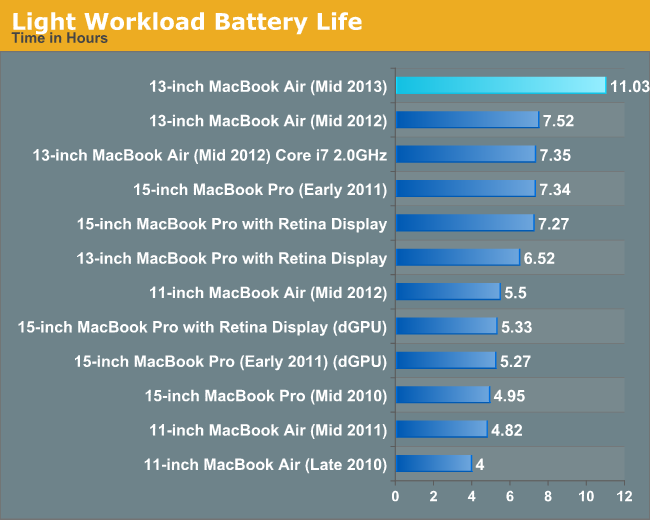
This is just ridiculous. Apple claims 12 hours, we tend to test a little more strenuous than Apple does and ended up with just over 11 hours of battery life on a single charge. These highly idle cases end up dominated by display power, which is why we actually see the smallest improvement in battery life over the previous generation here (~35%, normalized for battery capacity). If you drop brightness down to something more reasonable (~100 nits) you’ll get some truly insane numbers:
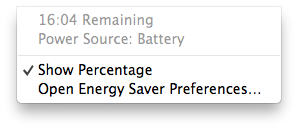
I remember owning a Transmeta Crusoe based Sony Picturebook (C1VN) with an extended battery and being able to break 14 hours of battery life. I had to give up so much performance and usability to get that sort of battery life back then; with the new MacBook Air, I don’t have to.
Now this is really the sort of battery life you can expect when using the 13-inch MBA as a glorified typewriter. What happens if you start using the system a bit more aggressively?

Just under 9 hours on a single charge, an increase of 54.5% when you normalize for battery capacity. What the world would’ve done if Haswell ULT hit prior to the creation of the iPad...
The reason I create/present three different battery life tests is to showcase a range of expected battery life. No one number is going to characterize what you can expect out of the system, but my hope is you’ll get a good idea of range by looking at the numbers here. The heavy test used to provide a good look at worst case scenario, but I’m beginning to wonder if I need something even more stressful:
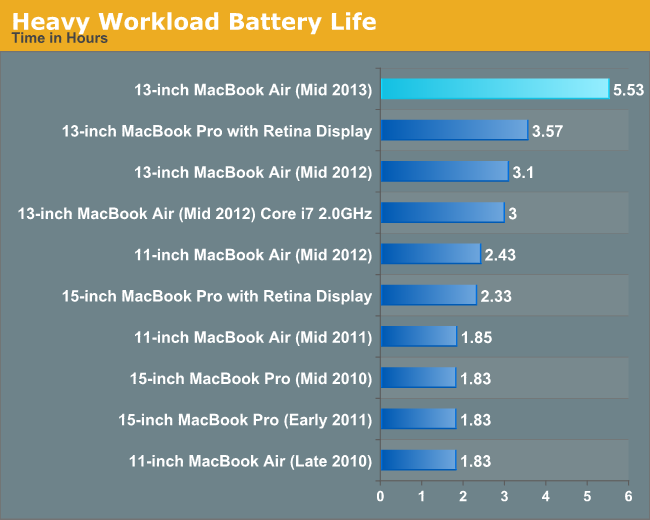
Even normalizing for battery capacity changes, the new 13-inch MacBook Air increases battery life by 65% over the previous model.
Under really heavy use (think tons of video/photo editing work) you can go even lower than what our heavy workload numbers show. In my experience I found that around 7 hours of battery life on a single charge is reasonable for most of my workloads, but when doing a lot of work (tons of Flash tabs open, compiling a project in the background and heavy multitasking) I could kill the 13-inch MBA in under 4 hours.
The benefit of the new MBA is really in its ability to extend its battery life when needed. Close Safari windows, turn down the brightness, and you’ve got a machine that can last for a very long time without needing a wall outlet. There's a good reason that OS X Mavericks focuses so much on putting background tasks/apps to sleep, maximizing idle time is really the key to getting this insane amount of battery life.


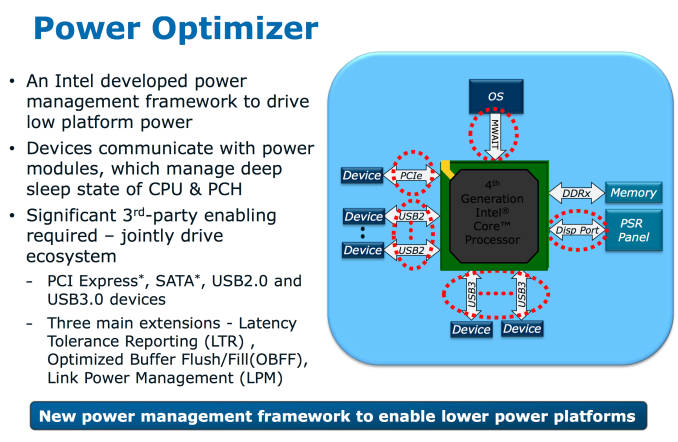








233 Comments
View All Comments
Skolde - Monday, June 24, 2013 - link
I find the current display resolutions on these "premium" products to be very lacking for me to actually seriously consider a purchase. At least stick something in there like 1600x900.....1366 x 768? Come on!
Also - bumping the memory up to 8GB would be nice. I know it isn't build to be a workhorse, but still.
The XPS13 from Dell seems to be a much nicer option currently.
rangerdavid - Monday, June 24, 2013 - link
1440 x 900 on this 13".ddriver - Monday, June 24, 2013 - link
Why not, they put higher resolution on 5 inch phones...darwinosx - Monday, June 24, 2013 - link
They put higher resolution screens on their retina laptops. The Air focus on battery life and performance above all.designerfx - Monday, June 24, 2013 - link
except that's a problem. You can't take advantage of certain basic parts of *performance* if you have a terrible display.dsumanik - Tuesday, June 25, 2013 - link
Here is the non TLDR version of this review:"intel came out with a new CPU, samsung made a new SSD and apple slapped it together last minute in an existing design. Ultimately, You get a slower, longer lasting air for a 100 bucks less that carries over all the little annoyances from last year."
whoop dee f*ckin do……..This is apple innovation?
"the m.2 spec wasnt far enough along to be used in this generation"
Oh please, What a load of horse ****. I think anand, like many other review sites invested heavily in apple stock and are now trying to stop the bleeding. Apple has been deliberately stifling user upgrades for years….That is why they have proprietary connectors…ON EVERYTHING...your readers, and your reviewer knows this.
"The only thing that hasn't changed, that perhaps should have is the display. "
ya think? My phone has better rez. You've been criticizing PC makers for 2 years about the 1366x768 resolution, and here we have apple in 2013 and you say they "perhaps should have changed"
ROFL
Here are some "cheap" things they could have done to actually make this product an upgrade:
-move the thunderbolt port beside the power connector (no more stethoscope when plugged in driving a display)
-second thunderbolt port (now you can have 2 displays native and not be down a precious USB3)
-16gb ram availability (now I can run several VM's comfortably when developing)
-performance on par with last years MBA?
-nfc support
-4G support
here is some mild innovation they could have done:
-detachable screen (tablet notebook hybrid)
-retina display
-wireless desktop charger
3rd tier PC makers are coming out with better hardware than apple now, this year was critical and they've dropped the ball…with the exception of the Mac pro.
a smartwatch *could* be cool if it comes out totally water proof for active users…jogging swimming etc, if not i don't see the incentive to purchase unless it is super low cost.
what they need to "fix" the situation
-low cost iPhone (incoming 2013)
-large screen iPhone (2014)
-retina display across the board on all products (2015)
-updated thunderbolt display, USB3 and 4k Rez for under 2000 bucks.
-apple branded TV and home theatre system
-thunderbolt or USB3 sync speeds on all iDevices
Dump your apple stock now, it will bounce back but never to the highs it was previously.
Glindon - Wednesday, June 26, 2013 - link
Bored much?abazigal - Wednesday, June 26, 2013 - link
Can you name me all the other manufacturers who are implementing these features, much less doing them properly?You want retina, there's the 13" retina MBP. And I think he was criticising manufacturers for using 1366x768 res on a 13" laptop screen. Apple uses that for their 11" MBA line, which I find is still acceptable.
Apple decided that a slight decrease in performance was an acceptable tradeoff for longer battery life. And I am inclined to agree with them. The new processor speed still more than suffices for what typical consumers use it for anyways.
What am I supposed to do with NFC on a laptop? You want the power source to be beside the thunderbolt port. I don't think there is quite sufficient space for 2 USB ports on one side, and so long as it hooks up to your thunderbolt display just fine, does it really irritate you so that the two cables split up?
Personally, I feel there is nothing Apple "needs" to do. I am perfectly fine with their products. I like them, I buy them.
ysaykin - Saturday, July 13, 2013 - link
I think that in a way the comments are right. 11 inch laptops for $1000 should have some luxury features. One of those is amazing battery life, good keyboard, nice display, and good performance. The macbook air has some bases covered, but lacks the display. The resolution is fine for a sub $600 notebook but not at $1000, also a TN panel on a $1000 notebook sounds like a rip off. It should have been at least an ips panel. The longer battery life is only achievable because Mac OSx has been optimized for battery life, but if you use windows on the machine your battery takes a huge dip. So is it a good laptop, definitely, but is it worth the $1000 price? I think it's def a mac tax. Look at the Lenovo yoga which if updated to haswell would have awesome battery life, touchscreen, ips 1600x900 resolution, and convertible to tablet mode.rudolphbyers - Thursday, October 9, 2014 - link
There's nothing that could replace my MacBook Air! /Rudolph from http://www.consumertop.com/best-laptop-guide/